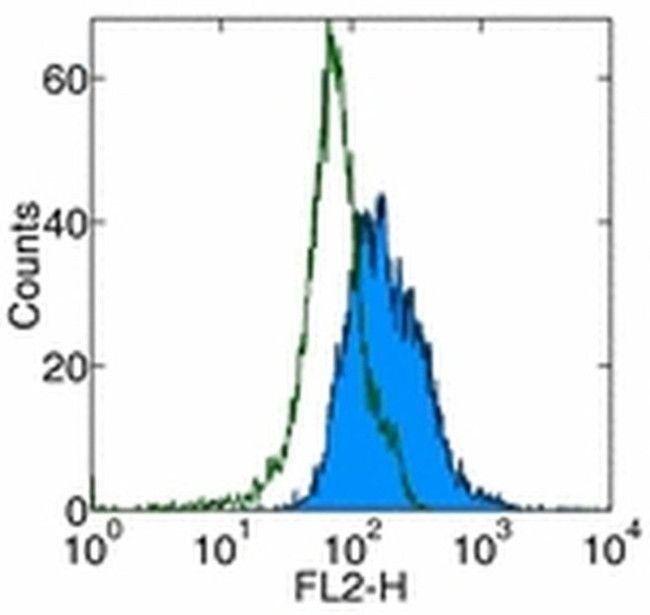Search Thermo Fisher Scientific
Invitrogen
CD263 (TRAIL-R3) Monoclonal Antibody (DJR3), PE, eBioscience™
Product Details
12-6238-42
Species Reactivity
Published species
Host/Isotype
Recommended Isotype Control
Class
Type
Clone
Conjugate
Excitation/Emission Max
Form
Concentration
Purification
Storage buffer
Contains
Storage conditions
Shipping conditions
RRID
Product Specific Information
Description: The DJR3 monoclonal antibody reacts with human Decoy receptor 1 (DcR1), a glycophospholipid-anchored cell surface protein also known as TRAIL-R3, TRID, and LIT. DcR1 has an extracellular TRAIL binding domain and lacks the cytoplasmic death domain (DD) shared by several members of the TNF receptor superfamily. DcR1, along with DcR2, protects cells from TRAIL-mediated cytotoxicity. DcR1 binds to TRAIL and inhibits binding of TRAIL to DR4 or DR5. DcR1 is expressed broadly in many normal tissues at low level, but not in most tumors. Overexpression of DcR1 attenuates TRAIL-induced apoptosis.
Applications Reported: The DJR3 antibody has been reported for use in flow cytometric analysis.
Applications Tested: This DJR3 antibody has been pre-titrated and tested by flow cytometric analysis of normal human peripheral blood cells and human DcR1-transfected cells. This can be used at 5 µL (1 µg) per test. A test is defined as the amount (µg) of antibody that will stain a cell sample in a final volume of 100 µL. Cell number should be determined empirically but can range from 10^5 to 10^8 cells/test.
Excitation: 488-561 nm; Emission: 578 nm; Laser: Blue Laser, Green Laser, Yellow-Green Laser.
Filtration: 0.2 µm post-manufacturing filtered.
Target Information
TRAIL-R3 (CD263) is a member of the TNF-receptor superfamily. This receptor contains an extracellular TRAIL-binding domain and a transmembrane domain, but no cytoplasmic death domain. This receptor is not capable of inducing apoptosis, and is thought to function as an antagonistic receptor that protects cells from TRAIL-induced apoptosis. This gene was found to be a p53-regulated DNA damage-inducible gene. The expression of this gene was detected in many normal tissues but not in most cancer cell lines, which may explain the specific sensitivity of cancer cells to the apoptosis-inducing activity of TRAIL.
For Research Use Only. Not for use in diagnostic procedures. Not for resale without express authorization.
How to use the Panel Builder
Watch the video to learn how to use the Invitrogen Flow Cytometry Panel Builder to build your next flow cytometry panel in 5 easy steps.
Bioinformatics
Protein Aliases: Antagonist decoy receptor for TRAIL/Apo-2L; CD263; cytotoxic TRAIL receptor-3; DcR1; Decoy receptor 1; Decoy TRAIL receptor without death domain; Lymphocyte inhibitor of TRAIL; MGC149501; MGC149502; TNF-related apoptosis-inducing ligand receptor 3; TRAIL receptor 3; TRAIL receptor without an intracellular domain; Tumor necrosis factor receptor superfamily member 10C; tumor necrosis factor receptor superfamily, member 10c, decoy without an intracellular domain
Gene Aliases: CD263; DCR1; DCR1-TNFR; LIT; TNFRSF10C; TRAIL-R3; TRAILR3; TRID; UNQ321/PRO366
UniProt ID: (Human) O14798
Entrez Gene ID: (Human) 8794

Performance Guarantee
If an Invitrogen™ antibody doesn't perform as described on our website or datasheet,we'll replace the product at no cost to you, or provide you with a credit for a future purchase.*
Learn more
We're here to help
Get expert recommendations for common problems or connect directly with an on staff expert for technical assistance related to applications, equipment and general product use.
Contact tech support


